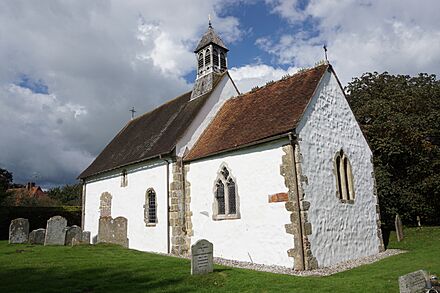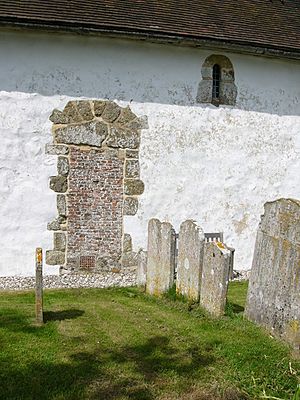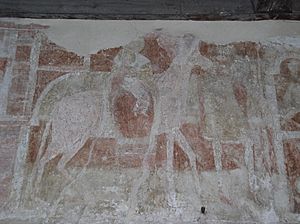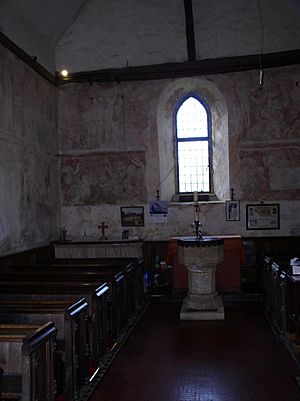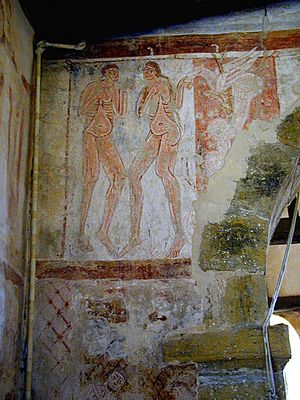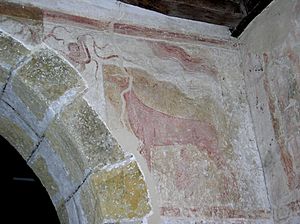St Botolph's Church, Hardham facts for kids
Quick facts for kids St Botolph's Church, Hardham |
|
|---|---|
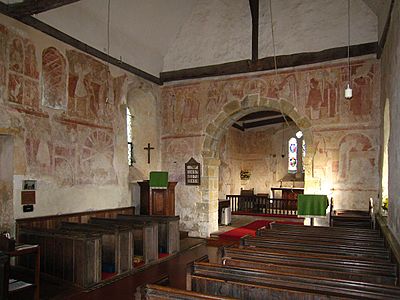
The Romanesque paintings
|
|
| 50°56′55″N 0°31′22″W / 50.948551°N 0.522789°W | |
| Location | Church Lane, Hardham, West Sussex RH20 1LB |
| Country | England |
| Denomination | Church of England |
| Website | Arun Churches |
| History | |
| Status | Parish church |
| Founded | 11th century |
| Dedication | St Botolph |
| Architecture | |
| Functional status | Active |
| Heritage designation | Grade I |
| Designated | 15 March 1955 |
| Style | Anglo-Saxon; Norman |
| Administration | |
| Parish | Hardham |
| Deanery | Rural Deanery of Petworth |
| Archdeaconry | Horsham |
| Diocese | Chichester |
| Province | Canterbury |
St Botolph's Church is a very old church in Hardham, West Sussex, England. It is a special building because it has some of the oldest and most complete wall paintings in England. These paintings are from the 12th century and show many different scenes, including the first known picture of St George in England. The church is a Grade I listed building, which means it is very important and protected.
Contents
History of the Church
Hardham village is near an old Roman road called Stane Street. This road was very important in Roman times. Even though the church wasn't mentioned in the Domesday Book of 1086, experts believe it was built in the late Saxon or early Norman period. This means it was finished by about 1125. Some stones and tiles from nearby Roman buildings were even used to build the church walls.
For a while, around 1250, a person called an anchorite lived in a small stone room attached to the church. An anchorite was someone who chose to live alone and pray. A special small opening, called a squint, was made so they could see the altar inside the church and receive Communion. This squint was later covered up but was found again around 1900.
Many churches in small villages like Hardham didn't change much over hundreds of years. This is because the villages didn't grow much, and there wasn't a lot of money to rebuild or add new parts. So, St Botolph's Church kept its simple, old look for a long time. In the 1800s, a porch and a small tower for the bell were added. This was also when the amazing wall paintings were discovered again after being hidden for centuries!
Church Design and Features
St Botolph's Church has a very simple design, with just two main rooms: the nave (where people sit) and the chancel (near the altar). The walls are thick and made of rough stone and flint. They even have some old Roman stones and tiles mixed in! The outside walls are covered in white plaster, which was common for churches a long time ago.
Inside, a simple arch separates the nave from the chancel. This arch shows the early Norman style of building. There are also small, old windows high up in the walls. Some of these are original Early English-style windows. The porch and bell-turret were added later, in the Victorian era.
The church also has some very old items inside. The font, used for baptisms, is from the 1400s. There are also old wooden benches. One of the two bells in the church might be from the early 1100s, making it one of the oldest bells in Sussex! The other bell was made in 1636.
The Amazing Wall Paintings
Introduction to the Paintings
The most famous part of St Botolph's Church is its incredible wall paintings, also known as frescoes. These paintings cover almost the entire inside of the church! They were painted in the early 12th century by a group of artists known as the "Lewes Group." Similar paintings can be found in a few other churches nearby.
These paintings are special because they are so old, cover such a large area, and are very well done. They are often called "the fame of Hardham" and "one of the most important sets in the country." For many years, these beautiful paintings were hidden under a layer of whitewash, put there in the 13th century. They were only uncovered again in the 1860s.
When Were They Painted?
The wall paintings were created in the early 12th century. This time period is known as the "Anglo-Norman" style, which you can also see in old books and even the famous Bayeux Tapestry. One of the scenes, showing St George in battle, helps us know the exact time. It was likely painted after the First Crusade (a big religious war) which happened between 1095 and 1099.
How Were They Made?
The artists used a special technique called true fresco. First, they put a thick layer of plaster on the walls. Then, they added a thinner layer of plaster in smaller sections. While this plaster was still wet, they painted on it. This way, the paint soaked into the plaster, making the colours last a very long time. The colours they used, like red, yellow, black, white, and green, came from cheap materials found nearby.
Since they were found in 1866, the paintings have been carefully looked after and restored many times to protect them from moisture and other damage.
What Do the Paintings Show?
The paintings tell many stories and show different themes. They are arranged in two rows along each wall. There used to be words above the pictures explaining them, but only a few of these words remain today.
Here are some of the main stories and scenes you can see:
- The Lamb of God: Above the arch leading to the chancel, there is a picture of the Lamb of God, which is a symbol for Jesus, surrounded by angels.
- The Early Life of Christ: Along the upper parts of the nave walls, you can see scenes from Jesus's childhood. These include his birth, angels telling shepherds the good news, the wise men's journey, and the flight into Egypt. One special scene shows the Annunciation (when an angel tells Mary she will have a baby) and the Visitation (Mary visiting her cousin Elizabeth). Above this scene, there are still some Latin words that mean: "The Virgin is saluted. The barren is proved fruitful."
- The Baptism of Christ: On the east wall of the nave, there is a painting of Jesus being baptized, though it is not very clear now.
- The Story of Dives and Lazarus: These paintings tell the story of a rich man (Dives) and a poor man (Lazarus) and what happened to them after they died.
- St George: These scenes are very important because they are the earliest known pictures of St George in a British church. They show St George fighting and also being tortured and buried.
- Hell Scenes: On the west wall of the nave, there are four paintings showing scenes of Hell, sometimes called the "Torments of the Damned."
- Adam and Eve: In the chancel, you can see scenes from the story of Adam and Eve. One unusual painting shows Eve milking a cow, which is a unique way to show her after leaving the Garden of Eden.
- The Passion and Resurrection: On the chancel walls, there are paintings showing events from the end of Jesus's life, including the Last Supper, his betrayal, and his resurrection.
- Apostles and Elders: The upper parts of the chancel walls show pictures of the Apostles and the Elders from the Apocalypse. There was once a painting of Christ in Majesty on the east wall, but it was destroyed when a window was added later.
St Botolph's Church Today
St Botolph's Church was given a Grade I listing on March 15, 1955. This means it is considered a building of "exceptional interest" and is very important to England's history. As of February 2001, it was one of 38 Grade I listed buildings in the Horsham area.
The church still holds services every Sunday, using the traditional Book of Common Prayer. It continues to be an active and important part of the Hardham community.
See also
- Grade I listed buildings in West Sussex
- List of places of worship in Horsham (district)
- St John the Baptist's Church, Clayton


